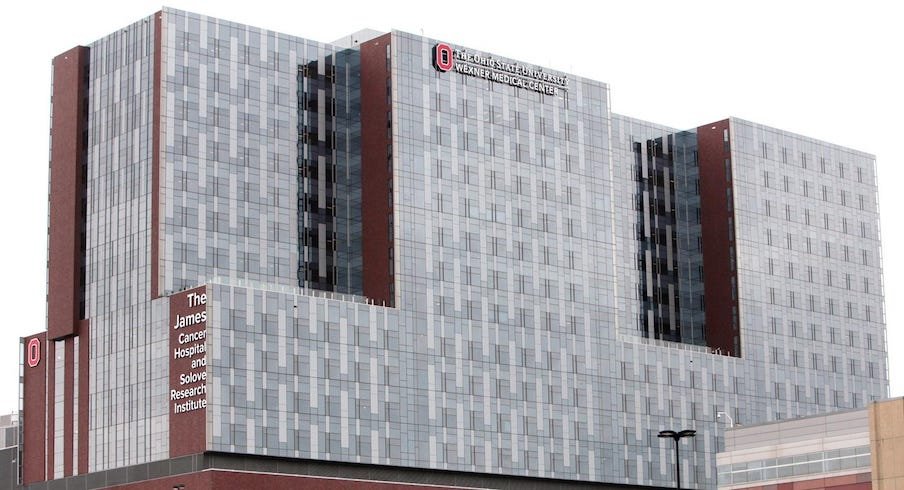Concerns surrounding the links between COVID-19 and heart issues, specifically myocarditis, was one of the reasons why the Big Ten decided to postpone fall sports on Aug. 11.
Whether the Big Ten votes in favor of playing football this fall this week could depend, in part, on whether the conference is confident it can mitigate those risks.
One way the Big Ten could make that happen: Using cardiac MRIs to detect possible cases of myocarditis in athletes who test positive for COVID-19.
In the midst of the debates that have taken place in the Big Ten and all over the country about the risks of playing sports during the COVID-19 pandemic, a group of Ohio State doctors and researchers conducted a study using cardiac MRIs – also known as CMR – to detect symptoms associated with myocarditis in college athletes who had tested positive for the virus.
One of the conclusions of that study, which was published Friday: “While long-term follow-up and large studies including control populations are required to understand CMR changes in competitive athletes, CMR may provide an excellent risk-stratification assessment for myocarditis in athletes who have recovered from COVID-19 to guide safe competitive sports participation.”
“The focus of our study was to see if we could do a test that could allow safe resumption of sports for those athletes, so that the doctors who are seeing these athletes feel safe about sending them back to competitive play. And if you rule out myocarditis by MRI, then sports cardiologists will feel safe about sending these athletes back into action,” said Ohio State cardiologist Saurabh Rajpal, the lead author of the study.
Ohio State’s study tested 26 competitive college athletes, and found swelling of the heart muscle indicating probable myocarditis in four of them. Eight other athletes had late gadolinium enhancement, which Rajpal said could be indicative of a prior heart injury like a virus, but could also simply indicate athlete heart adaptation due to how strenuously they exercise.
Because the study only involved 26 athletes, Rajpal said that data was not enough to draw any statistically significant conclusions about how high the risk of myocarditis associated with COVID-19 is. He also didn’t want to opine on whether sports should be played during the pandemic. At Ohio State, though, cardiac MRIs have been used to clear athletes to return to practice, in addition to the typical tests team doctors would conduct on athletes after they have been sick.
“When we started doing the study, our goal was to find something that we can feel safe about sending these athletes back,” Rajpal told Eleven Warriors. “In addition to doing the usual testing, in our opinion that was to do an MRI. So if you do an MRI, and the heart does not show myocarditis, at OSU we are letting the athletes go back to practice. We are letting them go back to usual intensity of exercise if their MRI was negative.”
The threat of myocarditis – inflammation of the heart muscle – has to be taken seriously by team doctors because it has been identified as a cause of sudden cardiac death in athletes. If an athlete has the condition and returns to action too soon, there could be grave consequences.
Myocarditis isn’t a new phenomenon, though, and it can be caused by other viruses as well; it’s simply getting more attention now because of how widespread the COVID-19 pandemic is.
“If somebody has swelling in their heart, and they keep on doing that high intense level of exercise, they are at risk of abnormal heart rhythms, and this could sometimes lead to death,” Rajpal said. “These are rare instances, I would point out, and myocarditis by itself is very uncommon. It’s not a common disease. But because the viral infection has affected so many people, we are talking about it more.”
James Borchers, the head physician for the Ohio State football team, was among those who co-authored the study with Rajpal. He is now serving as the co-chair of the medical subcommittee of the Big Ten’s return to competition task force, whose plans for returning to play were received positively by a steering committee of eight Big Ten presidents and chancellors on Saturday, which could lead to a vote on playing this fall as soon as Sunday. When he was asked about myocarditis by Ohio Gov. Mike DeWine during DeWine’s briefing on Aug. 18, he indicated that it was something doctors “need to be aware of,” but also something they don’t “need to be overly scared of.”
A significant figure in the #B1G return to play saga is Dr. Jim Borchers, #OhioState's lead team physician. Co-chairs B1G medical subcommittee with PSU AD Sandy Barbour. League sources tell me they're very impressed with Borchers. His voice and those of other doctors key tomorrow
— Adam Rittenberg (@ESPNRittenberg) September 12, 2020
Aaron Baggish, the director of the cardiovascular performance program at Massachusetts General Hospital, said Friday during a broadcast on the NCAA’s official social media account that he does not believe concerns about myocarditis should be a reason not to play college sports, believing that proper protocol can identify athletes who develop cardiac symptoms and keep them out of action until they fully recover.
“The algorithms we’ve put into place, I firmly believe, are going to identify the high-risk athletes that should be restricted, and that should be an individual decision among team physicians, sports cardiologists and the athlete who is a patient,” Baggish said. “The decision to play football or other collegiate sports right now is much more, in my opinion, about the ability to contain transmission of this virus as a public health issue rather than a cardiology issue.”
As for Ohio State’s research, Rajpal says the next step will include doing cardiac MRIs on athletes who have not tested positive for COVID-19 in order to compare their results against those who have. They will also do follow-up scans on athletes who have shown symptoms of myocarditis to see how they recover, while they also plan to test for blood markers to see if they can identify any indicators linked to myocarditis.
Ultimately, Ohio State’s research could allow them to draw more conclusions about how high the risk is of developing myocarditis as a result of a COVID-19 infection as well as whether there are other factors that make someone who contracts COVID-19 more likely to end up with heart-related issues, but they’re not there yet.
“I think there have been many studies that have shown the heart can be affected as a result of this infection. We just have to get more data and do more research to define how to identify that population in which the heart is affected,” Rajpal said. “And then move on and figure out what would be the next step to minimize danger, and move on from there.”


